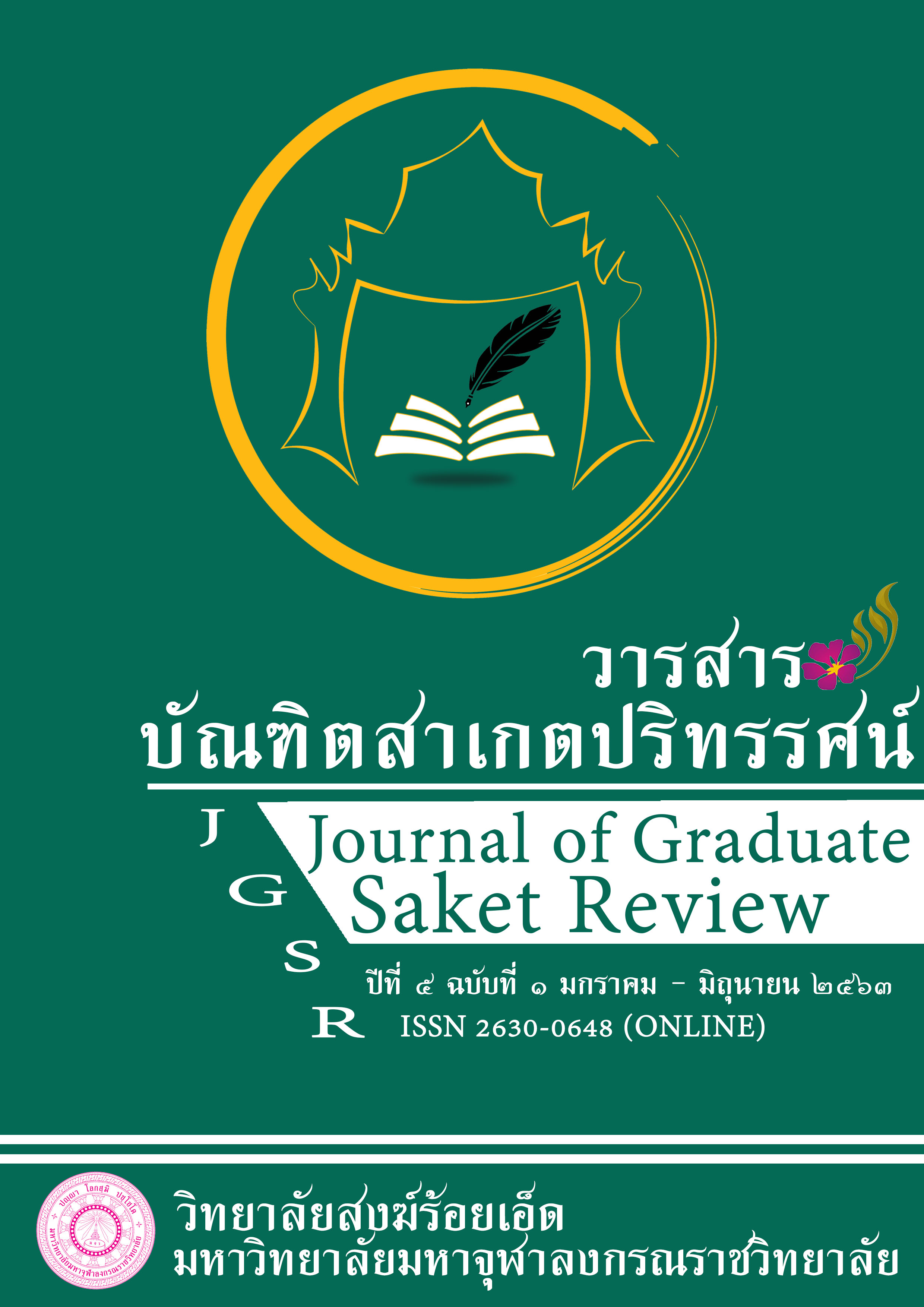THE APPLICATION OF THE MAIN BUDDHIST DHAMMA PROMOTE A PREVENTING PREMARITAL SEX IN PROJECT RESERVE THE CELIBACY OF PRANG KU SCHOOL STUDENTS, PRANGKU DISTRICT, SISAKET PROVINCE
Main Article Content
Abstract
This research aims to study the backgrounds of the reserve project. The Buddhist Dharma principles are to encourage the reserve which appears in Theravada Buddhism Scriptures and to propose guidelines for application of The Buddhist Dharma principles to encourage the reserve of the Prang Ku school students. Using research methodology in combination of the documentary and the quality, there were 15 people in-depth interview sample. The research found that: 1) The backgrounds of the project reserve celibacy to arising from the establishment of a group for a making a beloved “King youth program”, it aim to reduce the risk of having sex in the school the student's school, Prang Ku. Grade level school in the year 2549 BC, until now by the supporting from the school, the main Prang Ku 2) the Buddhist Dharma applied to promote the reserving the celibacy; five precepts, the five ennobling virtues, leaning from others and systematic attention, moral shame moral dread, mindfulness, clear comprehension, virtues for a good household life, qualities of a good man, controlling six facultys, and Concentration (Samatha) and insight development (Vipassana kammatthan) 3) The Buddhist Them applied the guidelines to promote to reserving the celibacy By bringing these principles to organize activities on reserving the celibacy the training, seminars, describing, teaching to preach to immunization both body, mind, and wisdom, in particular the consideration of fundamental factors for 2 reasons; internal factors are systematic attention to ponder the example smartly and external factors are the leaning from others, it is a good social environment to induce right view, which is the source of goodness, the student realizes the value to reserve the celibacy, In order they prevent sex aged properly and appropriately.
Article Details
เนื้อหาและข้อมูลในบทความที่ลงตีพิมพ์ในวารสารบัณฑิตสาเกตปริทรรศน์ ถือเป็นข้อคิดเห็นและความรับผิดชอบของผู้เขียนบทความโดยตรงซึ่งกองบรรณาธิการวารสาร ไม่จำเป็นต้องเห็นด้วย หรือร่วมรับผิดชอบใด ๆบทความ ข้อมูล เนื้อหา รูปภาพ ฯลฯ ที่ได้รับการตีพิมพ์ในวารสารบัณฑิตสาเกตปริทรรศน์ ถือเป็นลิขสิทธิ์ของวารสารบัณฑิตสาเกตปริทรรศน์ หากบุคคลหรือหน่วยงานใดต้องการนำทั้งหมดหรือส่วนหนึ่งส่วนใดไปเผยแพร่ต่อหรือเพื่อกระทำการใด ๆ จะต้องได้รับอนุญาตเป็นลายลักอักษรจากวารสารบัณฑิตสาเกตปริทรรศน์ ก่อนเท่านั้น
References
ณิฐินันท์ วิชัยรัมย์. (2545). การศึกษาปัจจัยที่มีอิทธิพลต่อพฤติกรรมเสี่ยงต่อการมีเพศสัมพันธ์ของนักเรียนระดับมัธยมศึกษาตอนปลาย ในเขตอำเภอเมือง จังหวัดบุรีรัมย์. วิทยานิพนธ์ศิลปศาสตรมหาบัณฑิต. บัณฑิตวิทยาลัย: มหาวิทยาลัยศิลปากร.
นฤมล สุขศิริ. (2556). อิทธิพลของสื่อที่ส่งผลต่อความเสี่ยงของการมีเพศสัมพันธ์ของนักเรียนระดับชั้นมัธยมศึกษา โรงเรียนในเขตอำเภอเมือง จังหวัดฉะเชิงเทรา. วิทยานิพนธ์ศิลปศาสตรมหาบัณฑิต. บัณฑิตวิทยาลัย: มหาวิทยาลัยราชภัฎหมู่บ้านจอมบึง.
พระพรหมคุณาภรณ์ (ป.อ. ปยุตฺโต). (2557). พุทธธรรม ฉบับปรับขยาย, พิมพ์ครั้งที่ 39. กรุงเทพมหานคร: มหาจุฬาลงกรณราชวิทยาลัย.
พระไพศาล วิสาโล. (2560). การเสริมสร้างพลังทางศีลธรรมในสังคมไทย. จาก http://www. visalo.org/article/budKarnsermsang.htm.
รางวัล สุขี. (2551). ปัจจัยเสี่ยงต่อการมีเพศสัมพันธ์ของนักเรียนระดับมัธยมศึกษาตอนปลาย กรณีศึกษาจังหวัดนครปฐม. วิทยานิพนธ์ศึกษาศาสตรมหาบัณฑิต. บัณฑิตวิทยาลัย: มหาวิทยาลัยราชภัฏนครปฐม.
ลือชัย ศรีเงินยวง. (2552). คู่มือการทำงานเพื่อนำหลักพุทธธรรมมาแก้ปัญหาสุขภาพทางเพศและการเจริญพันธ์ของวัยรุ่น. กรุงเทพมหานคร: องค์การการศึกษาวิทยาศาสตร์และวัฒนธรรมแห่งสหประชาชาติ.
สำนักอนามัยการเจริญพันธุ์ กรมอนามัย กระทรวงสาธารณสุข. (2547). สถิติการคลอดของแม่วัยรุ่นประเทศไทย ปี พ.ศ. 2556. กรุงเทพมหานคร: สำนักงานกิจการโรงพิมพ์องค์การสงเคราะห์ทหารผ่านศึก ในพระบรมราชูปถัมภ์.


